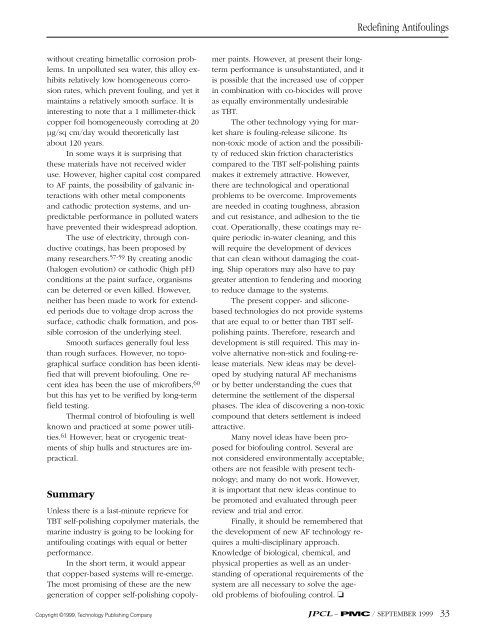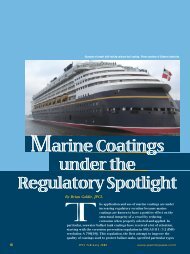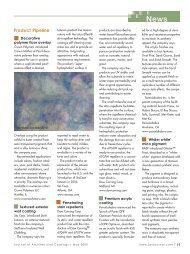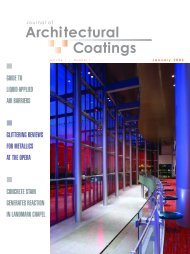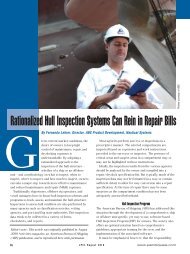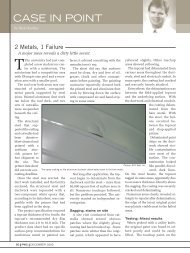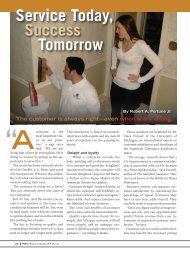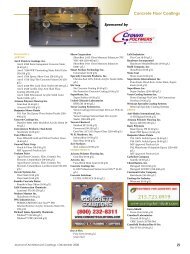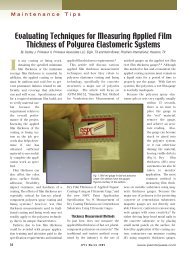Redefining Antifouling Coatings - PaintSquare
Redefining Antifouling Coatings - PaintSquare
Redefining Antifouling Coatings - PaintSquare
You also want an ePaper? Increase the reach of your titles
YUMPU automatically turns print PDFs into web optimized ePapers that Google loves.
<strong>Redefining</strong> <strong>Antifouling</strong>swithout creating bimetallic corrosion problems.In unpolluted sea water, this alloy exhibitsrelatively low homogeneous corrosionrates, which prevent fouling, and yet itmaintains a relatively smooth surface. It isinteresting to note that a 1 millimeter-thickcopper foil homogeneously corroding at 20µg/sq cm/day would theoretically lastabout 120 years.In some ways it is surprising thatthese materials have not received wideruse. However, higher capital cost comparedto AF paints, the possibility of galvanic interactionswith other metal componentsand cathodic protection systems, and unpredictableperformance in polluted watershave prevented their widespread adoption.The use of electricity, through conductivecoatings, has been proposed bymany researchers. 57-59 By creating anodic(halogen evolution) or cathodic (high pH)conditions at the paint surface, organismscan be deterred or even killed. However,neither has been made to work for extendedperiods due to voltage drop across thesurface, cathodic chalk formation, and possiblecorrosion of the underlying steel.Smooth surfaces generally foul lessthan rough surfaces. However, no topographicalsurface condition has been identifiedthat will prevent biofouling. One recentidea has been the use of microfibers, 60but this has yet to be verified by long-termfield testing.Thermal control of biofouling is wellknown and practiced at some power utilities.61 However, heat or cryogenic treatmentsof ship hulls and structures are impractical.SummaryCopyright ©1999, Technology Publishing CompanyUnless there is a last-minute reprieve forTBT self-polishing copolymer materials, themarine industry is going to be looking forantifouling coatings with equal or betterperformance.In the short term, it would appearthat copper-based systems will re-emerge.The most promising of these are the newgeneration of copper self-polishing copolymerpaints. However, at present their longtermperformance is unsubstantiated, and itis possible that the increased use of copperin combination with co-biocides will proveas equally environmentally undesirableas TBT.The other technology vying for marketshare is fouling-release silicone. Itsnon-toxic mode of action and the possibilityof reduced skin friction characteristicscompared to the TBT self-polishing paintsmakes it extremely attractive. However,there are technological and operationalproblems to be overcome. Improvementsare needed in coating toughness, abrasionand cut resistance, and adhesion to the tiecoat. Operationally, these coatings may requireperiodic in-water cleaning, and thiswill require the development of devicesthat can clean without damaging the coating.Ship operators may also have to paygreater attention to fendering and mooringto reduce damage to the systems.The present copper- and siliconebasedtechnologies do not provide systemsthat are equal to or better than TBT selfpolishingpaints. Therefore, research anddevelopment is still required. This may involvealternative non-stick and fouling-releasematerials. New ideas may be developedby studying natural AF mechanismsor by better understanding the cues thatdetermine the settlement of the dispersalphases. The idea of discovering a non-toxiccompound that deters settlement is indeedattractive.Many novel ideas have been proposedfor biofouling control. Several arenot considered environmentally acceptable;others are not feasible with present technology;and many do not work. However,it is important that new ideas continue tobe promoted and evaluated through peerreview and trial and error.Finally, it should be remembered thatthe development of new AF technology requiresa multi-disciplinary approach.Knowledge of biological, chemical, andphysical properties as well as an understandingof operational requirements of thesystem are all necessary to solve the ageoldproblems of biofouling control. ❏JPCL – PMC / SEPTEMBER 1999 33


